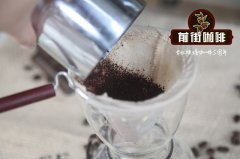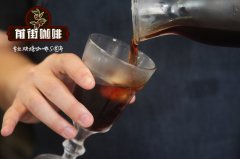Taiwan Alpine Coffee | Wuhe platform | Wuhe Coffee | the sun at Mizuho Manor in Hualien

Professional coffee knowledge exchange more coffee bean information please follow the coffee workshop (Wechat official account cafe_style)
The manor is located in Wuhetai Village, Ruisui Township, Hualien. Ghanana is the Ami language "Kalala", which means "basket" and also explains the topography of the area. There are more than 400 residents, most of whom are Ami aborigines. It is a village with agriculture as its main economic activity. During the Japanese occupation era, the Japanese came here to reclaim the land under the orders of the Japanese governor. In the 1930s, he established a coffee farm of about 400 hectares and set up a company for export. It is the one-stop base for the production, manufacture and sale of coffee in Taiwan during the Japanese occupation era.
The Jilin Tea Garden, located in the village of Kanana, has an annual output of about 500 kilograms. It uses the old Japanese-occupied plants to establish a coffee garden and uses the experience of the tea garden to produce coffee. This batch uses annual fresh beans, refined by the sun, the taste spectrum contains strong fermented aromas, pine, peaches, baked nuts, raw walnuts, black tea, sweet and lasting.
In Mizui Township, Hualien, on the Wuhe platform, there is a small village named "Ghanana". The name comes from the Ami language "Kalala", which means "basket" and describes the topography of the area. There are more than 400 residents, most of whom are Ami aborigines. It is a village with agriculture as its main economic activity. Since the Japanese occupation, coffee, pineapple and tea have been planted successively.
The Wuhe platform where Ghanana is located is called "sweeping platform" in ancient times. "Sao Bao" means wooden plank in Ami. Legend has it that hundreds of years ago, Ami people came here to reclaim land. When they were hit by a storm, they picked up nearby plank-shaped objects for shelter, so they called this place "Sao Bao". In the post-Japanese occupation era, the Japanese came here for reclamation under the orders of the Japanese Governor, and with the help of Ma Youyue and other local gentry, established a coffee farm of about 400 hectares here in the 1930s, and set up a "Sumitada Co., Ltd." to market to Japan and provide drinking to the emperor, which was the birthplace of Taiwan's earliest corporate coffee cultivation.
After the outbreak of the Pacific War, Masaji Kuoda left Taiwan. After the war, Taiwan coffee lost Japan, the largest market, and Wuhe coffee gradually declined, and it has been decades since. It was not until the rise of Gukeng Coffee in recent years that Wuhe residents remembered this glorious history and went back to the fields to look for the coffee trees of that year and start planting again.
Coffee trees for decades are still full of vitality in the natural environment. Wuhe Terrace is full of old birds left over from that year, and each seed carries memories of the Japanese occupation era. As residents put into planting, the output of Wuhe coffee increased year after year, gradually opening up its popularity, but at the same time it began to face the problem of production and marketing channels.
Wuhe platform has good water quality, fertile soil and abundant coffee production. Wuhe coffee farmers mostly take the tea garden as the main source of income, and coffee production is only a sideline. From Dongsheng Tea Garden, which takes the lead in planting, to Jilin Tea Garden, where Sengao Sand Coffee cooperates, are all examples. Residents have made various attempts from developing sightseeing coffee farms to establishing brands. However, due to the high cost of coffee production and different treatment methods, a complete production and marketing system has not been established so far. This has also led to the fact that although Wuhe coffee is famous, it is quite difficult to sell it. Some farmers simply do not harvest it to save costs, or sell coffee beans wholesale to other counties and cities under the name of other producing areas.
Jilin Tea Garden, located in the village of Kanana, provides an opportunity for improvement. Mr. Peng Weixiang, a tea farmer, is a young tea farmer. Through years of efforts, he has gradually increased the output of coffee in the manor and developed many different coffee treatments on his own. Benefiting from his tea garden experience, Mr. Peng put tea-making equipment into coffee production, from using the fermentation room for dry fermentation and water washing to using tea-making wilt carving equipment for coffee honey treatment, which not only created a new flavor for Wuhe Coffee, but also expanded its production capacity. provide a small amount of reprocessing services for nearby farmers.
The cooperation between Sengao Sand Coffee and Jilin Tea Garden allows Wuhe Coffee to establish a complete industrial chain from production to marketing. In the past, limited by geographical location, Wuhe coffee was always sold in local packaging, but this cooperation can shorten the distance between producing areas and consumers, and make use of the flexible and unique production capacity of Jilin tea garden. with the excellent baking quality of Sengao sand coffee to the marketing channel, and then extended to other farmers to enhance the product value with the quality and image of boutique coffee, and gradually expand the benefits of Wuhe coffee as the top producing area of Taiwan coffee.
About the tanning method
Natural is one of the oldest ways to treat raw coffee beans. It is said that Arabs have used this method for post-processing of coffee fruits since the 11th century. The sun-drying method is to evenly expose the harvested coffee fruit to the sun, turn it several times a day until the fruit is dry and the internal moisture content of the coffee reaches a certain standard, and then remove the dry and hard peel of the fruit. that is, the sun-dried coffee beans with strong fermented aroma are obtained.
The sun-drying method consumes a lot of labor, and the consumption rate of raw beans is also high, so the price is generally higher. However, because the process does not require water consumption, it is generally very popular in the Middle East or parts of Africa where water resources are scarce. Because the whole fermentation process is completed in the pericarp of coffee, the alcohol thickness, fermentation aroma and sweetness of the sun-drying method are extremely strong, the acid value is more obvious, the complexity of the taste spectrum is high, and the level is clear.
Taiwan has more rain and less sunshine, and the labor cost is higher than that of other coffee producing areas, and the output of sun beans is less. The sun-dried beans selected by Sengao sand coffee come from farmers who have cooperated with our company for a long time and have a certain scale. Its production process and quality stability are guaranteed. Among them, some farmers use equipment such as making tea and shiitake mushrooms to assist in sun-drying and fermentation, so that the sun-dried bean series of Sengao sand coffee has a special flavor different from that of international beans.
Qianjie coffee: Guangzhou bakery, the store is small but a variety of beans, you can find a variety of unknown beans, but also provide online store services. Https://shop104210103.taobao.com
Important Notice :
前街咖啡 FrontStreet Coffee has moved to new addredd:
FrontStreet Coffee Address: 315,Donghua East Road,GuangZhou
Tel:020 38364473
- Prev

Legendary Manor Las Lajas Perla Negra in Costa Rica | Black Pearl
Professional coffee knowledge exchange more coffee bean information please follow the coffee workshop (Wechat official account cafe_style) front street boutique coffee recommendation | Costa Rica Shumawa black honey | Costa Rica Angel Manor Las Lajas is one of the pioneer estates in Costa Rica. In 2000, the price of coffee in Costa Rica fell a lot, but the cost of farming
- Next

Ethiopia | Yega Xuefei producing area | 2018 Adadot Cooperative Adado Solar G1
Professional coffee knowledge exchange more coffee bean information please follow the coffee workshop (Wechat official account cafe_style) Ethiopia Ethiopia Yirgacheffe Adado Ethiopia Yirgacheffe Adado Adado Cooperative Solar G1 (Ye Jia Xuefei) Variety: local native species (Typica Heirloom) producer: Adado (Adado)
Related
- Does Rose Summer choose Blue, Green or Red? Detailed explanation of Rose Summer Coffee plots and Classification in Panamanian Jade Manor
- What is the difference between the origin, producing area, processing plant, cooperative and manor of coffee beans?
- How fine does the espresso powder fit? how to grind the espresso?
- Sca coffee roasting degree color card coffee roasting degree 8 roasting color values what do you mean?
- The practice of lattes: how to make lattes at home
- Introduction to Indonesian Fine Coffee beans-- Java Coffee producing area of Indonesian Arabica Coffee
- How much will the flavor of light and medium roasted rose summer be expressed? What baking level is rose summer suitable for?
- Introduction to the characteristics of washing, sun-drying or wet-planing coffee commonly used in Mantenin, Indonesia
- Price characteristics of Arabica Coffee Bean Starbucks introduction to Manning Coffee Bean Taste producing area Variety Manor
- What is the authentic Yega flavor? What are the flavor characteristics of the really excellent Yejasuffi coffee beans?

